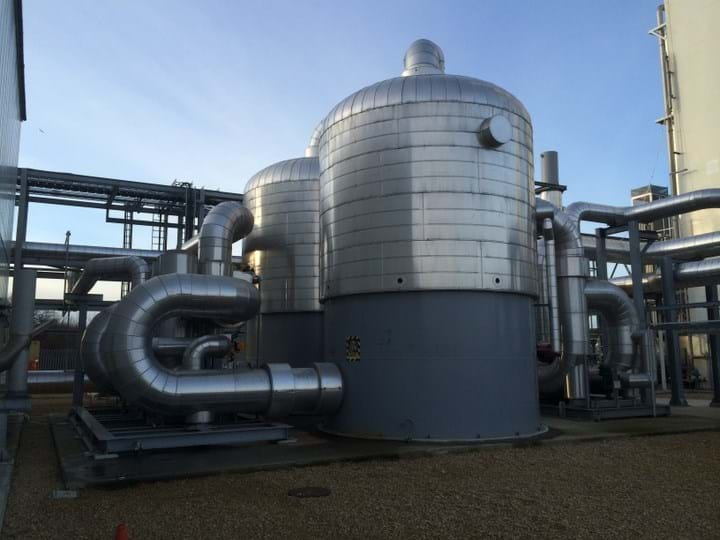Air Separation: Cryogenic or Not?

FROM the mass production of steel to the manufacture of sophisticated micro-chips and semi-conductors by leading technology firms, air separation plants – and specifically access to the right volume and purity of oxygen and nitrogen – are critical to the successful operations of a variety of manufacturing and engineering businesses.
Oxygen and nitrogen can be extracted from atmospheric air using both cryogenic and non-cryogenic air separation processes. So how can chemical engineers choose between the two processes and what does each involve?
Non-cryogenic air separation is ideal for lower-volume processes where cost efficiency is key and lesser purity acceptable. Typically, purities of 85–95% oxygen purity and 95% or better nitrogen purity are achievable using a non-cryogenic process.
By contrast, cryogenic air separation suits a high-volume process where purities of around 99.5% O2 and parts per billion O2 in N2 may be required. Ultimately, each situation is different and any approach should be tailored and bespoke to requirements, with the focus firmly on achieving the most economic outcome.
What's the difference?
In both processes, the air is compressed and the heat of compression is removed. Sometimes further cooling is achieved via shell-and-tube exchangers or direct contact aftercoolers using both cooling water and chilled water.
Downstream of air cooling, the two methods of production differ significantly. For cryogenic plant, to ensure safety and facilitate an efficient process, it is critical that contaminants such as CO2, water vapour and heavy hydrocarbons are removed from the air. This is achieved using temperature swing adsorption (TSA). The adsorber vessels contain beds of activated alumina and molecular sieves. They operate cyclically, alternating between adsorption and regeneration, achieved with dry waste gas. Some of the lighter hydrocarbons pass through the TSA and into the cold box where their concentration is monitored and controlled.
In the non-cryogenic process, hydrocarbons, moisture and particulates are removed using carbon towers, filters and mist eliminators. The process gas then enters a pressure swing adsorption twin-bed system using a carbon molecular sieve which separates oxygen and CO2 from the air.
Different adsorbents attract certain gases more strongly than others. For example, in nitrogen production, oxygen is preferentially adsorbed on the bed whilst a nitrogen-rich stream is recovered as product. Exhaust gases are vented to atmosphere. Other technologies such as membranes are used to produce typically 95–99.5% nitrogen in typical volumes of 25 t/d. Vacuum swing adsorption is an alternative means of low-purity oxygen production for markets such as glass, wastewater treatment, cement production, bio-fuels, metals production, pulp and paper and steel. The range of oxygen production varies from 5–500 t/d.
ASU cycle
Cryogenic air separation units (ASUs) then take the air through another cycle of treatment to extract gases of a higher purity of volumes in excess of 4,000 t/d per ASU.
This involves air liquefaction and distillation. The boiling points of pure gases are -183oC for oxygen and -196oC for nitrogen at atmospheric pressure. By compressing the air, heat integration within the cold box is allowed and nitrogen is condensed against boiling oxygen in the low-pressure column reboiler.
Cycle selection is dependent on product purity, range of products and whether gas or liquid products are required. Choosing the optimal configuration is vital to minimising capital and operating costs.
The cold box contains distillation columns operating at a range of pressures. The clean air stream is cooled in a main heat exchanger (MHE) before flowing to a high-pressure column, with a fraction of the cooled air expanded to provide refrigeration to the plant. Alternative means of refrigeration may be employed; for example liquid nitrogen (LIN) injection.
In the high-pressure column, the liquid from the bottom of the column becomes enriched with oxygen, while the vapour passing up to the top of the column steadily increases in nitrogen purity. Gaseous nitrogen product is taken from the top of the high-pressure column.
The vapour at the top of the column is then fed to the low-pressure column reboiler where it is condensed. A portion of the condensed nitrogen returns to the high-pressure column as reflux, and at this point a stream of condensed nitrogen may be sent to storage as LIN product.
Within the low-pressure column, oxygen is withdrawn as a liquid from the sump. It may be pumped as a liquid when high pressure gaseous oxygen is required. A low-pressure waste stream may be obtained from the column, warmed in the MHE and used for TSA regeneration. Furthermore, pure argon may be produced by withdrawing a feed stream from an optimal location and processing in a separate distillation column system.

Take your pick
Both cryogenic and non-cryogenic air separation processes have their advantages dependent on the specified volume and purity. Employing the right approach and the most appropriate cycles is critical if chemical engineers are to ensure air separation plants operate at maximum efficiency, and the highest levels of safety. Whilst ambient processes may be simpler but sometimes less efficient than cryogenic technology, they offer more flexibility for batch processing, with short startup and shutdown times and considerably less equipment. In contrast, air separation units have multiple design options which allow the whole range of atmospheric gases to be recovered.
Recent Editions
Catch up on the latest news, views and jobs from The Chemical Engineer. Below are the four latest issues. View a wider selection of the archive from within the Magazine section of this site.




